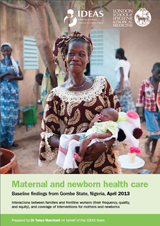
About the survey
The IDEAS baseline study of interactions between families and frontline workers and coverage of critical interventions for mothers and newborns was conducted in June 2012 in Gombe State, North-Eastern Nigeria.
Its aim was to gather information about the frequency, quality, and equity of interactions that women have with frontline workers during pregnancy, delivery and in the first 28 days after birth, and to measure the coverage of life saving interventions that frontline workers are able to deliver to mothers and newborns. In the context of Gombe State, frontline workers include community volunteers, traditional birth attendants, and health staff at primary level health facilities.
In addition to a descriptive analysis of interactions and intervention coverage, our purpose was to investigate whether more frequent or better quality interactions between families and frontline workers were associated with higher levels of intervention coverage. At least two years after baseline, an endline survey will also be carried out to investigate the extent to which projects working in Gombe State that aim to enhance family and frontline worker interactions (by making them more frequent, better quality and more equitable) result in measurable increases in intervention coverage.
Summary of results
Overall, the survey results present a picture of maternal and newborn health care in Gombe State that is comparable to other high mortality settings in sub-Saharan Africa.
Two-thirds of women access pregnancy care at least once but fewer than half have the recommended four visits, and the quality of care received was low when measured at the population level – due to frontline workers not providing appropriate counselling as well as to facilities not being fully equipped. Only around half of women were benefitting from any of the life saving interventions available to them in pregnancy. A much smaller number of women accessed facility based intra-partum care, fewer still had skilled attendance at birth. There were large differences in the quality of health care that a frontline worker was able to deliver depending on her place of work, and on her knowledge of appropriate care. The coverage of life saving intrapartum interventions that should reach all women when giving birth was low, particularly for those giving birth at home: if an increase in skilled attendance at birth could be realised however, there was indication that coverage of these interventions could increase dramatically. Post partum and post natal care were almost completely absent in the State, being provided mainly to the least poor families. But even when post-partum or post-natal care interactions took place, they did not appear to be having a measurable effect on life saving behaviours in the first days after birth. It will be important to consider the changes that newly trained frontline workers might be able to make happen over the next phase of work in Gombe, and before the endline survey takes place.